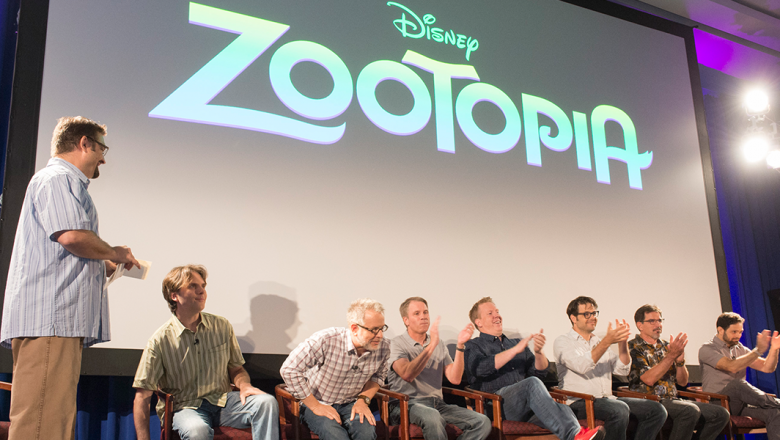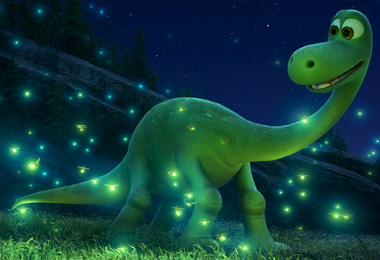Like the song goes, it’s all happening at the zoo—although in this case, it’s all happening at Zootopia! In a special panel in Stage 28 at D23 EXPO 2015 today, hosted by animator Darrin Butters, a 19-year veteran of Walt Disney Animation Studios (WDAS), the filmmakers behind the upcoming feature, which opens March 4, 2016, took us through their research process and showed us an assortment of hilarious clips from the movie and from their creative process.
The idea for Zootopia originated with director Byron Howard (Bolt, Tangled), who brought the concept of a movie with talking animals that walk upright—and wear clothes—to John Lasseter, chief creative officer of Pixar Animation Studios and WDAS.
“I loved the legacy of our great animal movies at Disney, like Bambi, The Jungle Book, Dumbo.”
Once Howard and his fellow filmmakers—director Rich Moore (The Simpsons, Wreck-It Ralph), producer Clark Spencer (Lilo & Stitch, Wreck-It Ralph, Bolt), writer/co-director Jared Bush (Penn Zero: Part-Time Hero), writer Phil Johnston (Wreck-It Ralph), production designer Dave Goetz (Tangled), and head of animation Renato dos Anjos (Wreck-It Ralph, Frozen)—started focusing on animals, they began the research process for the film. And as fans of Disney and Pixar Animation know, research is extremely important to John Lasseter.
Lasseter sent the team to Disney’s Animal Kingdom in Florida, for a preliminary trip, and then to the Savanna of Africa. “It was life-changing,” Howard said. Bush concurred, saying, “Stepping out of that airplane, it really felt like you were in the animals’ world. Immediately we were seeing giant herds of giraffes. Once you get closer to these animals you get a different perspective on how they move, how they smell…”
The creative talents at WDAS innovate with each new film. They’ve gone from 2008’s Bolt, where, they joke, they had to be careful of including too many windows, which would cause Bolt’s hair to blow, to 2016’s Zootopia, where they are now able to create hundreds of thousands of strands of clear polar bear fur. Yes, we learned from the animators that polar bears’ fur isn’t really white, it’s clear.
Production designer Dave Goetz explained that since the different lands and worlds of Zootopia are designed by animals for animals, they had to accommodate a wide range of animal sizes. “For when they travel, we made different sized trains.” Acclaimed auto designer J Mays even designed different sized cars for the animals, which range in size from mice to elephants.
Visual development art shown at the presentation shows different neighborhoods, like Little Rodentia, and The Burrows, for bunnies… where the population is literally always multiplying. The land is divided mostly by habitat, and the climates range from the desert-like Sahara Square to chilly Tundra Town, which has coolers in the sidewalk. Another plus to Tundra Town, Moore jokes, “is that we get to reuse all of the snow we have left from Frozen.”
The story, according to the filmmakers, is about bias and stereotypes. “Judy is a real optimist and she lives by the mantra that in Zootopia, anybody can be anything,” Johnston said. Later in the presentation, Howard professed that animation is an amazing medium because you can address complicated issues without targeting them head-on. “You get to appreciate the message of the movie without it being in your face.”
All of the filmmakers are thrilled to be part of WDAS’ storied legacy. Howard admits that legendary animators Milt Kahl and Marc Davis were influences, and they know that the films that influenced Zootopia—The Jungle Book and Bambi—were shot on the same lot where they work now. “We walk through those halls all the time,” Howard said. Moore adds that the design sense for Zootopia “comes from that same DNA.”
The audience in Stage 28 was treated to sneak peeks of clips that demonstrated Zootopia’s humor—who knew sloths could be so funny?—and heart, and all were thrilled to get this early look at the film from the people who are making it. The feeling was mutual, Moore said. “We spend so much time at the studio, in a bubble, making these films. To have moments like this where we get to share what we’re working on is very special.” It was a special afternoon, indeed!





